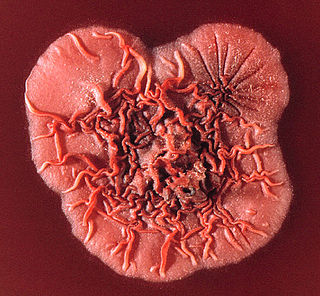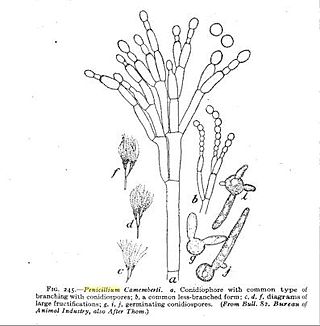
A mold or mould is one of the structures that certain fungi can form. The dust-like, colored appearance of molds is due to the formation of spores containing fungal secondary metabolites. The spores are the dispersal units of the fungi. Not all fungi form molds. Some fungi form mushrooms; others grow as single cells and are called microfungi.

Penicillium is a genus of ascomycetous fungi that is part of the mycobiome of many species and is of major importance in the natural environment, in food spoilage, and in food and drug production.

Talaromyces marneffei, formerly called Penicillium marneffei, was identified in 1956. The organism is endemic to southeast Asia where it is an important cause of opportunistic infections in those with HIV/AIDS-related immunodeficiency. Incidence of T. marneffei infections has increased due to a rise in HIV infection rates in the region.
A mycotoxin is a toxic secondary metabolite produced by fungi and is capable of causing disease and death in both humans and other animals. The term 'mycotoxin' is usually reserved for the toxic chemical products produced by fungi that readily colonize crops.

Penicillium roqueforti is a common saprotrophic fungus in the genus Penicillium. Widespread in nature, it can be isolated from soil, decaying organic matter, and plants.

Penicillium camemberti is a species of fungus in the genus Penicillium. It is used in the production of Camembert, Brie, Langres, Coulommiers, and Cambozola cheeses, on which colonies of P. camemberti form a hard, white crust. It is responsible for giving these cheeses their distinctive flavors. An allergy to the antibiotic penicillin does not necessarily imply an allergy to cheeses made using P. camemberti.

Penicillium expansum is a psychrophilic blue mold that is common throughout the world in soil. It causes Blue Mold of apples, one of the most prevalent and economically damaging post-harvest diseases of apples.

A fungus is any member of the group of eukaryotic organisms that includes microorganisms such as yeasts and molds, as well as the more familiar mushrooms. These organisms are classified as one of the traditional eukaryotic kingdoms, along with Animalia, Plantae and either Protista or Protozoa and Chromista.

Penicillium chrysogenum is a species of fungus in the genus Penicillium. It is common in temperate and subtropical regions and can be found on salted food products, but it is mostly found in indoor environments, especially in damp or water-damaged buildings. It has been recognised as a species complex that includes P. notatum, P. meleagrinum, and P. cyaneofulvum. Molecular phylogeny has established that Alexander Fleming's first discovered penicillin producing strain is of a distinct species, P. rubens, and not of P. notatum. It has rarely been reported as a cause of human disease. It is the source of several β-lactam antibiotics, most significantly penicillin. Other secondary metabolites of P. chrysogenum include roquefortine C, meleagrin, chrysogine, 6-MSA YWA1/melanin, andrastatin A, fungisporin, secalonic acids, sorbicillin, and PR-toxin.
Penicillium carneum is a fungus species of the genus of Penicillium.Penicillium roqueforti var. carneum was reclassified to Penicillium carneum.P. carneum was isolated from spoiled meat products, silage, rye bread, water, beer, cheese, mouldy barkers yeast and cork. P. carneum produces patulin, penicillic acid, penitrem A, mycophenolic acid roquefortines.
Penicillium citrinum is an anamorph, mesophilic fungus species of the genus of Penicillium which produces tanzawaic acid A-D, ACC, Mevastatin, Quinocitrinine A, Quinocitrinine B, and nephrotoxic citrinin. Penicillium citrinum is often found on moldy citrus fruits and occasionally it occurs in tropical spices and cereals. This Penicillium species also causes mortality for the mosquito Culex quinquefasciatus. Because of its mesophilic character, Penicillium citrinum occurs worldwide. The first statin (Mevastatin) was 1970 isolated from this species.
Penicillium coralligerum is a species of the genus of Penicillium. It is a marine species sometimes referred to as a deep-sea fungus and in some languages named the equivalent of "deep-sea mold".
Penicillium corylophilum is a species of the genus of Penicillium which occurs in damp buildings in United States, Canada and western Europe but it can also be found in a variety of foods and mosquitoes. Penicillium corylophilum produces the alkaloid epoxyagroclavine and citrinin and is a pathogen to mosquitoes.
A species of the genus of Penicillium which causes Blue Mold of Garlic on Allium sativum L. The genus name is derived from the Latin root penicillum, meaning "painter's brush", and refers to the chains of conidia this fungus produces that resemble a broom.
Penicillium psychrosexualis is a filamentous fungus in the genus Penicillium. Described as new to science in 2010, the species was found growing on refrigerated moldy apples in the Netherlands. It is closely related to the blue cheese fungus P. roqueforti.
Penicillium polonicum is a species of fungus in the genus Penicillium which produces penicillic acid, verucosidin, patulin, anacine, 3-methoxyviridicatin and glycopeptides. Penicillium polonicum can spoil cereals, peanuts, onions, dried meats, citrus fruits
Penicillium rugulosum is an anamorph species of fungus in the genus Penicillium which produces inulinase, luteoskyrin and (+) rugulosin.

Penicillium solitum is an anamorphic, mesophilic, salinity-tolerant, and psychrotolerant species of fungus in the genus Penicillium. It is known to produce various compounds including polygalacturonase, compactin, cyclopenin, cyclopenol, cyclopeptin, dehydrocompactin, dihydrocyclopeptin, palitantin, solistatin, solistatinol, viridicatin, viridicatol.

Cladosporium cladosporioides is a darkly pigmented mold that occurs world-wide on a wide range of materials both outdoors and indoors. It is one of the most common fungi in outdoor air where its spores are important in seasonal allergic disease. While this species rarely causes invasive disease in animals, it is an important agent of plant disease, attacking both the leaves and fruits of many plants. This species produces asexual spores in delicate, branched chains that break apart readily and drift in the air. It is able to grow under low water conditions and at very low temperatures.
Penicillium variabile is an anamorph species of fungus in the genus Penicillium which has been isolated from permafrost deposits. Penicillium variabile produces rugulovasine A and rugulovasine B This species occurs on wheat, flour, maize, rice, and barley, and it is also very common in indoor environments.









